Menu
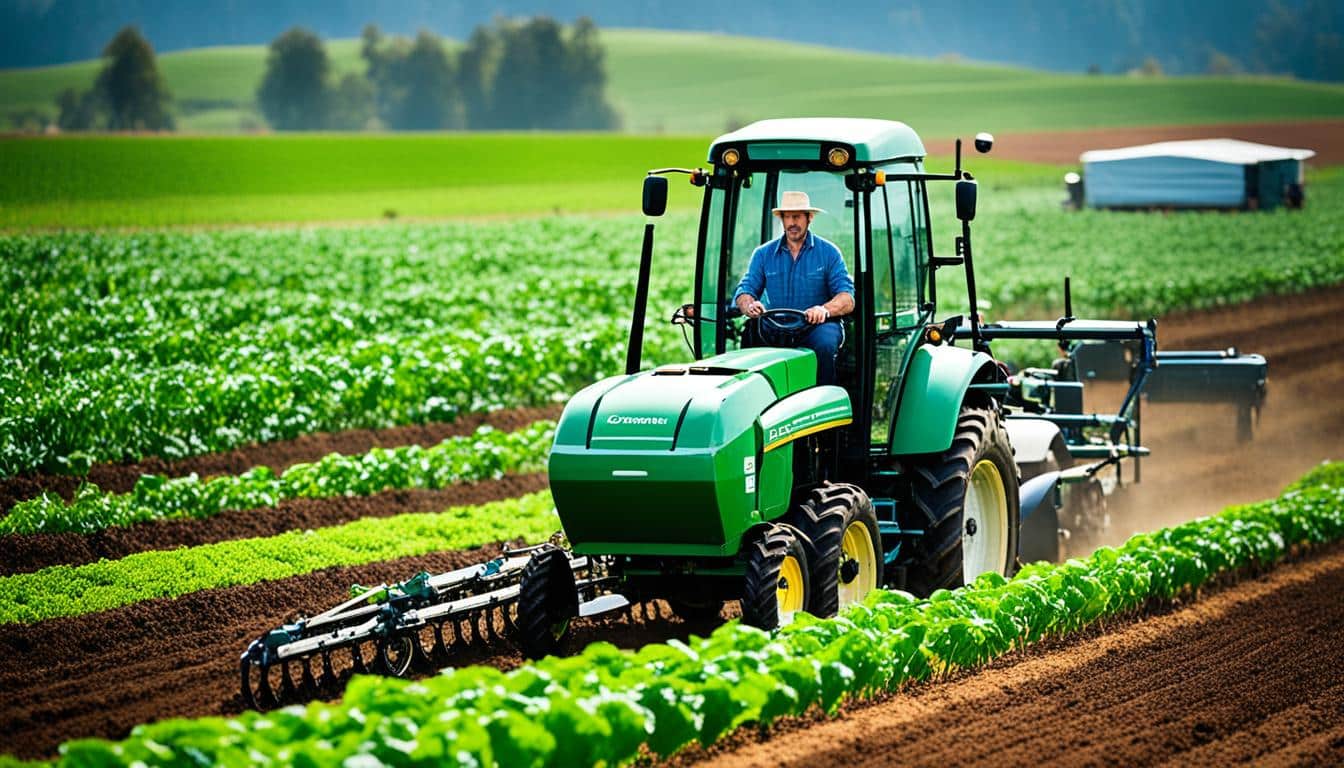
Did you know that farming is going through a big change, all thanks to tech? The National Academy of Sciences says this shift is redefining how we farm. As someone who cares about our planet, I know it’s key to use eco-friendly farming tools. These tools, like sensors that check the soil and the weather, help us farm better. They let us use less and make more, reducing waste and being kinder to the earth.
Picking the right materials is crucial for green farming tools. We’re choosing earth-friendly stuff over the usual materials that harm our planet. For instance, we’re using biodegradable things and steel that we’ve used before instead of new ones. By doing this, we’re cutting down on the bad stuff we put out there. Plus, we’re also using the sun’s power with solar panels. This not only keeps our earth clean but also saves money on running the farm.
Another cool thing we’re doing is using smart tech and being really precise in our farming. This means we’re making sure not to waste anything and that our crops grow well. We’re using things like drones that can see things we can’t and systems that watch over our farm from afar. These high-tech ways give farmers more power to make better choices for the planet.
Sustainable agriculture is a key response to the big environmental issues caused by old farming ways. These ways led to bad things like deforestation and soil damage. Now, we’re moving to new, eco-friendly ways to make sure our food systems last.
The use of sustainable agriculture tools is changing farming. It protects the environment, makes sure farms are profitable, and treats people fairly. Over the last 40 years, this approach has become more popular. People are realising the need to use resources wisely today and for the future. Using sustainable methods helps solve the damage old farming did to nature. It makes farm systems stronger.
Farming faces big challenges today, like climate change and soil erosion. Our old ways made these problems worse. Now, we must find ways to fix this. Innovations, such as sensors and drones, help us collect data and manage resources better. Sustainable farming tools lessen the harm we do to the planet. They’re key in moving towards greener methods. By tackling these problems, we not only improve food security but also safeguard our planet for the next generations.
Using advanced technology and gene editing has great potential in sustainable farming. It can boost crop production and their ability to fight diseases. This makes sustainable farming a strong and smart solution in our environment’s fight.
In our search for ways to be kinder to the planet, biodegradable farming tools are standing out. They’re made from bioplastics, coming from things like cornstarch and sugarcane. This change is shaping how we see farming gear. These materials break down naturally, which helps fight pollution and stops waste build-up.
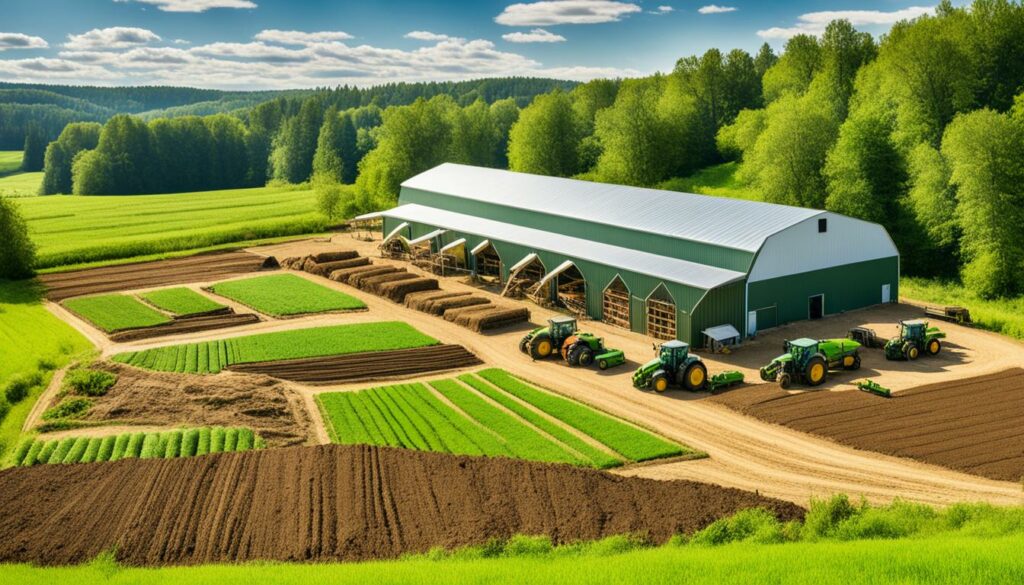
Thanks to these new materials, farming can be more earth-friendly. They make sure the tools don’t harm the planet when they’re no longer needed. This step is a big part of supporting green efforts in farming.
One key plus of these materials is they cut down on harm to the environment. Because they break down, they don’t add to the piles of waste. Also, since farming can cause a lot of greenhouse gases, using these materials helps cut down on that.
What’s more, unlike normal plastics, using these materials can keep the soil healthy. The overuse of plastic in farming has hurt the soil and the plants. So, these new tools are a better choice for our farms.
Some examples of these eco-friendly tools are mulch films and planting pots that break down. They help keep the soil good for plants. The films also help with weeding, keeping pests away, saving water, controlling the temperature, and making plants grow better.
In places like Europe and Asia, people are using these films a lot. They’re finding them very helpful. Also, a recent global agreement, the Plastics Treaty, shows the world’s serious about cutting down plastic pollution.
| Regions | Usage of Biodegradable Mulch Films (kg/ha) |
|---|---|
| Europe | 40-50 |
| Asia | 40-50 |
| North America | 10-20 |
| South America | 10-20 |
Choosing biodegradable tools is good for both the planet and us. As more people live on Earth, using these tools makes sure we keep our world safe. So, farmers using bioplastics show they care about our future.
Using reclaimed steel in farming marks a big step towards being eco-friendly. It helps cut down on using new resources, saves energy, and builds a strong farming industry. Each year, the UK’s building sector uses about 400Mt of materials.
This creates over 120Mt of waste. Yet, steel can be recycled completely. This means using old steel lessens the burden on our planet.
Recycled steel offers one big plus: it’s really tough. Equipment made from old steel lasts long. It also saves a lot of energy and material needed to make new steel.
Each year, 96% of steel from buildings gets recycled. In 2019, 32% of all steel was made from scrap. These facts show how useful old steel is in farming and other fields.
Also, it’s good for the wallet. In January 2021, the UK sold scrap steel for about £230 to £240 a tonne. This is cheap for farmers looking for sturdy equipment and who want to save money.
Real-life stories show how using old steel benefits farming. For instance, many machine makers use old steel to create ploughs and harrows. These items are not just strong, but also good for the environment.
These success stories prove that recycled steel helps agriculture a lot. It cuts down on harm to the environment. And it shows a positive move towards a greener farming future.
Consider looking at this article for more on steel recycling.
Using energy wisely in farming machinery is key to greener farming. Thanks to new technology, farming machines are becoming more energy-efficient. This helps the farming industry cut down on its carbon output.
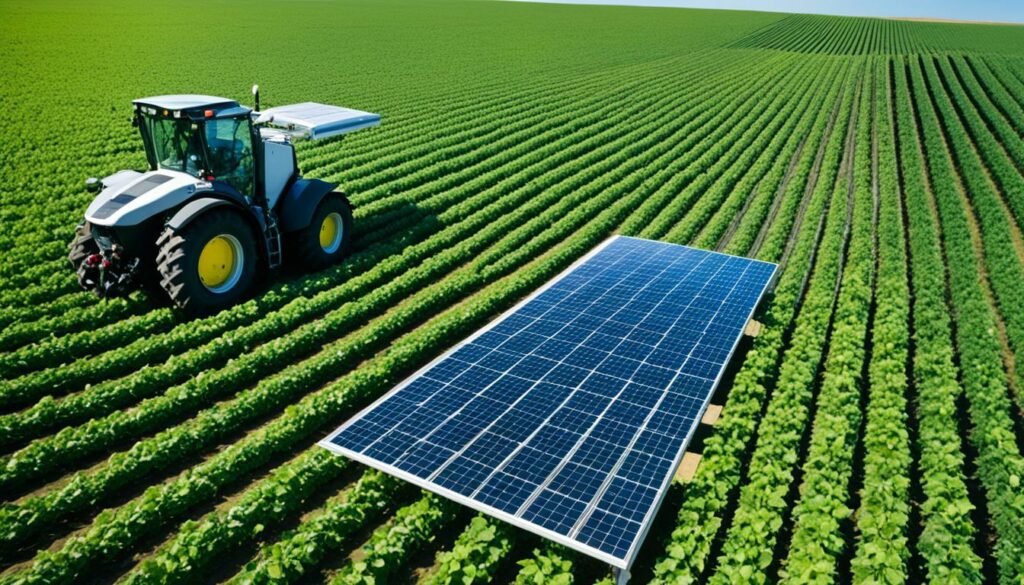
Choosing energy-saving machinery lowers the carbon footprint of farms. Today, makers of farming tools aim to use less energy but work just as well. In China, the use of advanced tools for growing crops has risen. For wheat, corn, and rice, more energy-friendly machines are now used. This shows a big move towards eco-aware farming.
Energy-save machines bring more than just environmental good. They slash costs for farmers, too. Less fuel use means spending less money over time. Plus, these machines help farming be more sustainable. For example, in China, there’s less soil erosion and cleaner water, thanks to better farming tools. This proves how energy-saving machinery is good for the Earth.
Choosing eco-friendly farming helps fight climate change. The EU wants to cut down CO2 emissions by 55% by 2030. Energy-efficient farming machines are a big part of reaching this target. Also, keeping track of pollution in farming helps to be even greener. It leads to a farming system that’s better for everyone.
Solar-powered farming tools are changing the game. They offer a clean and renewable way to power our work. These tools can keep going for over 25 years, giving us energy just when we need it.
One great thing about using the sun for power is how cheap it is to run. Solar panels turn sunlight into electricity without needing much attention. This means farms can count on steady energy without huge bills.
Also, solar power can make money for farmers. Excess electricity can be sold, boosting farm incomes. This helps them move away from dirty energy, lowering their impact on the planet.
Solar panels are tough enough for farm life. They last a long time and quickly pay for themselves with savings. Plus, making power on the farm means being more independent from the grid.
People really like farms that are good for the planet. Choosing solar power makes a farm more appealing and profitable. It’s a win-win for everyone.
Solar energy is a big help for the Earth. It cuts back on pollutants and saves the planet. Plus, there’s a tax break in Minnesota for going solar, making it even more appealing.
From saving money to being reliable, solar panels fit right into farming. They show us a bright future where farming and the environment thrive together.
| Benefit | Detail |
|---|---|
| Lifespan | 25 years or more, ensuring long-term reliability |
| Cost Savings | Low operational costs and potential for additional revenue through net metering |
| Environmental Impact | Reduces greenhouse gas emissions and reliance on non-renewable energy sources |
| Durability | Highly durable, ideal for agricultural environments |
| Tax Incentives | Federal ITC provides a 30% tax credit for solar projects |
Precision farming uses GPS to make agriculture better. It connects skills in farming with new technology. This helps grow better crops and uses resources carefully.
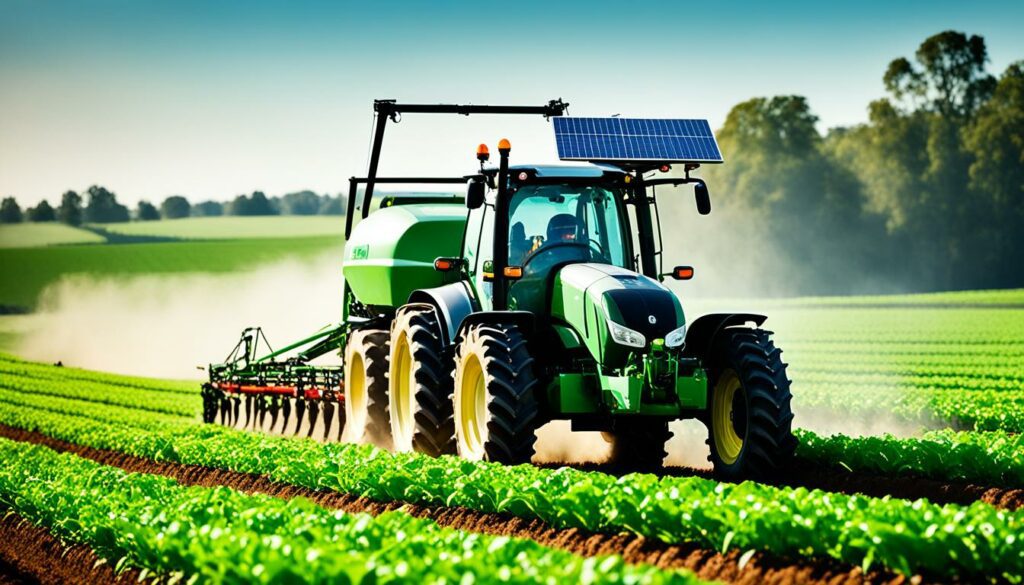
GPS helps farmers watch and direct their work closely. The USDA says more than half of big crop fields use smart machines. This means using resources well, cutting waste, and keeping crops healthy.
GPS also makes farming kinder to the environment, cutting down on pollution. The EPA notes farming is a big source of America’s greenhouse gases. By using GPS and other tech like drones and special software, farms can do better while being greener.
Using GPS in farming takes planning. First, fields are mapped to learn about the soil and plants. By using smart gear, farmers pick the best spots to put fertilisers and pesticides. This way, they cut waste and help the environment.
The average farmer’s age is around 57, shows the 2022 Agriculture Census. Teaching older farmers to use GPS well is key. And, keeping the tech safe from cyber attacks with strong passwords and updates is just as important.
Putting GPS in farming looks to the future. It combines new tech with old farming wisdom. It helps make farming not just better, but also greener and more sustainable too.
Smart technology is changing farming, especially in managing water and fertiliser. By 2050, the world’s population is expected to grow by 34%. This means we need to grow more food and use resources better. Smart irrigation and data-driven fertilisation play a big role in this change.
Smart irrigation helps farmers use water better. It uses sensors and IoT to monitor soil moisture. This ensures plants only get the water they need, reducing waste. These systems are not just for big farms. They are helpful for small farms too.
This technology also boosts plant growth and supports eco-friendly farming. Farming usually uses a lot of water, cuts down on environmental harm. It also makes farming more efficient.
Farming now uses data to apply fertiliser more effectively. This helps crops grow better and uses less harmful chemicals. It’s good for the environment. Farmers can now use big data to give the right nutrients to each crop.
There are also tools like EOSDA Crop Monitoring. They use satellites to check on crops and soil. This helps farmers use fertilisers better. It saves them money and helps the environment too.
| Technology | tAdvantages | tChallenges |
|---|---|---|
| Smart Irrigation Systems | tOptimises water use, reduces waste, enhances plant productivity | tLack of internet access, need for standardisation |
| Data-Driven Fertilisation | tImproves fertiliser efficiency, reduces nutrient runoff, lowers costs | tLow awareness, challenges in scalability |
Using the latest tech is key in farming today to meet the hunger for more food by 2050. Real-time crop watching and advanced pest control are vital. They help make sure crops are healthy and produce more.
Real-time crop watching uses high-tech sensors to check on crop health. Taranis uses AI and checks over 200 million data points to watch fields closely. John Deere’s smart farming tools boost crop growth by using GPS and data checks. Machines from companies like Tortuga AgTech reduce the need for people to watch the crops. This makes work easier and boosts output.
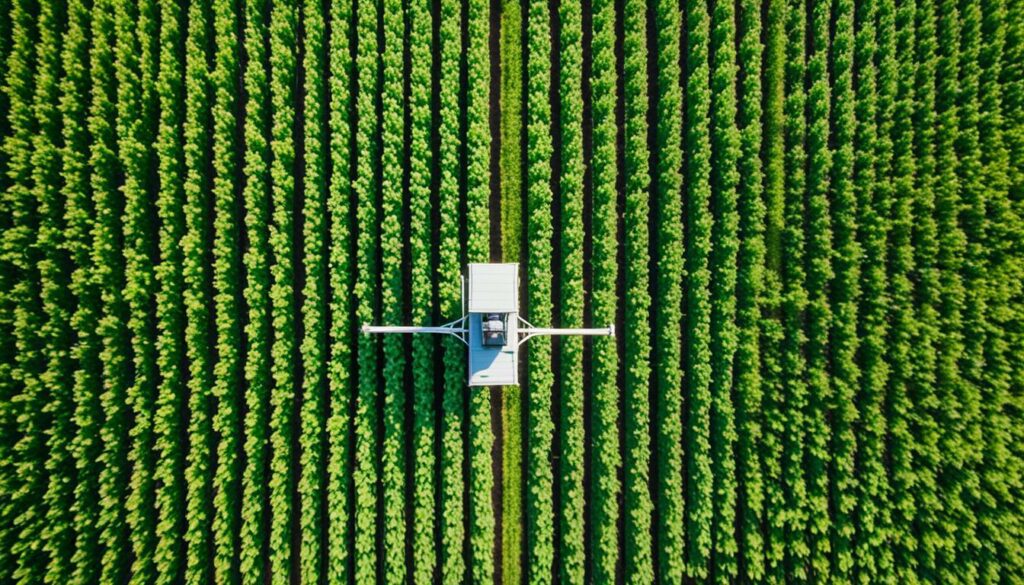
Pests can cut down the crops by 40%, so advanced pest solutions are important. Instead of old sticky traps, tools like FlightSensor by FarmSense give up-to-the-minute info on pest numbers. They can even guess when pest outbreaks might happen, cutting costs and helping the planet. Less spraying of harmful chemicals is needed. These techs also help farms cut down on their carbon emissions by reducing manual work.
Vertical farming has come forward as a cutting-edge way to farm sustainably and in a smaller space. It makes use of special indoor environments to grow crops. This tackles big environmental issues that normal farming faces.
Vertical farming brings many benefits, with reduced water use being a top one. It can save up to 90% more water than traditional farming. That’s a massive win for our planet. What’s more, it needs nearly zero land.
This farming method also means more crops can be grown in a smaller space. In fact, it can produce up to 240 times more food in the same area. This allows for food to be grown all year round.
One key area where vertical farming shines is in being eco-friendly. By using green energy and managing waste well, it cuts carbon emissions by about 30%. It’s a big step towards a cleaner Earth.
In urban areas, it can help turn food deserts into green, food-rich places. By growing food closer to where it’s needed, it lowers pollution. This method also keeps food safe from harmful substances, reducing the need for pesticides.
| Benefits | Traditional Farming | Vertical Farming |
|---|---|---|
| Water Usage Reduction | N/A | 70-90% |
| Land Savings | N/A | 99% |
| Yield Increase | N/A | 240 times |
| Carbon Footprint Reduction | N/A | Up to 30% |
| Emissions Reduction | N/A | 50-60% |
Vertical farming is a smart and sustainable way to grow food. It’s key to feeding more people in cities in the future.
Electric tractors have changed the game in farming. Now, more farmers choose these green options. Big names in the industry, like John Deere, Monarch, and Knegt, are leading the charge.
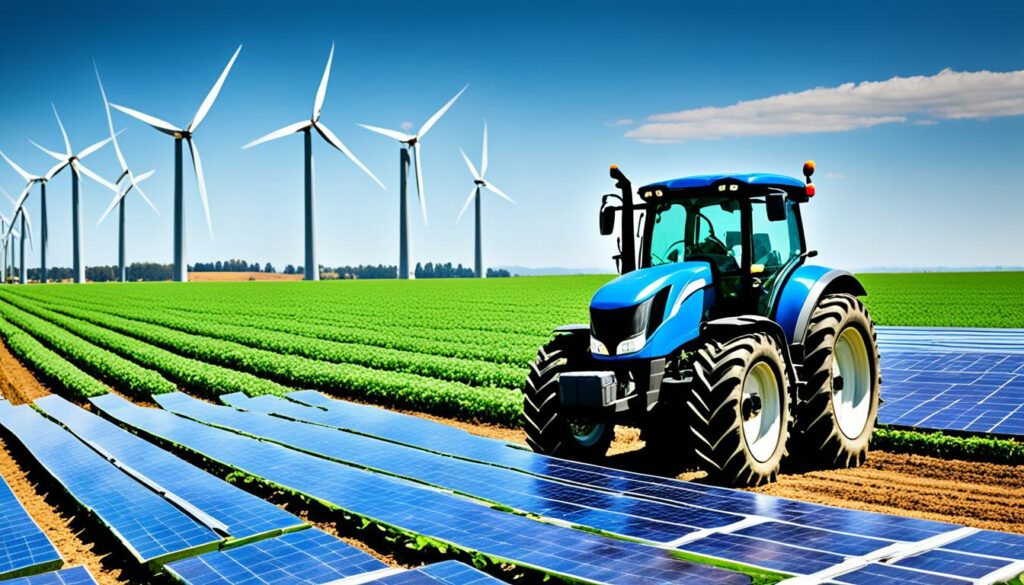
Moving to electric farm tools has many perks. For instance, Monarch Tractor’s MK-V lasts up to 14 hours on one charge. It’s a great swap for diesel, and it charges fully in just six hours. This quick recharging means less downtime and more work done.
Choosing electric over diesel is great for the earth and your pocket. Diesel fumes can harm crops and the environment. On the other hand, electric tractors don’t pollute at all. They help keep plants and the planet safe. Plus, farmers save lots of money on fuel, as much as $198,000 every year, according to Monarch Tractor.
The electric tractor market is set to grow a lot. It might reach USD 3.4 billion by 2030, from USD 0.7 billion in 2024, says MarketsandMarkets™.
Organic farming methods are great for our environment. They use natural processes and avoid harmful chemicals. This way, the crops and the soil they grow in stay healthy. It leads to a diverse and strong agricultural environment.
Organic farming is all about keeping the soil and nature in balance. Farmers enrich the soil by using natural methods. They turn to compost, crop rotation, and green manure. This keeps the soil fertile and safe from harmful chemicals.
Organic farming boosts soil health significantly. It improves soil structure and fertility with regular additions of organic matter. These methods also prevent soil erosion. This keeps the top layer, where plants grow, healthy. By changing which crops are grown, farmers keep the land diverse. This diversity invites helpful organisms, keeping the ecosystem in balance.
The adoption of organic farming methods not only secures the health of our soil but also nurtures a resilient agricultural biodiversity that is essential for sustainable production.
Choosing organic farming supports our land and the life it holds. It reduces the need for outside resources. This method ensures our agriculture works in harmony with nature, for a healthier planet.
In 2030, our world will include about 9 billion people. It’s crucial to address both climate change and food security. Agricultural biotechnology offers ways to boost crop yield, improve nutrients, control weeds, and fight off diseases and pests. It does this without harming our planet.
Genetically modified crops are key for sustainable crop breeding. In Brazil and Argentina, a drought-resistant wheat increases carbon storage by 7%. It also yields 20% more in dry areas. A special corn can increase yields by 10% because its leaves grew 8-9% bigger, adapting well to different conditions.
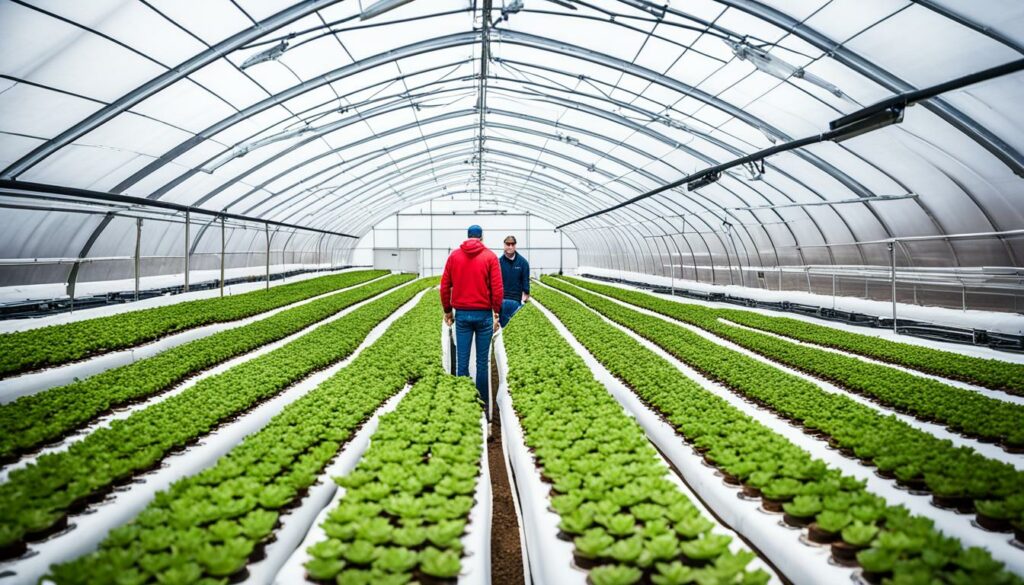
Agricultural biotechnology boosts how much food we can produce. Yet, the gain is not as much as needed to feed us all. But, new types of rice with 30% larger seeds can cut down methane a lot.
But, there are debates about genetically engineered crops. People worry about their effect on the environment and our health. Even with those worries, biotechnology is vital for sustainable farming. It shows how farming can grow food and protect nature at the same time.
Combining these new farming methods points us towards farming that’s good for the planet and our pockets. Agriculture’s future success relies on biotechnology. It deals with the problems we face now and those we will face later.
| Crop | Annual Yield Increase | Required Growth Rate |
|---|---|---|
| Maize | 1.6% | 2.4% |
| Rice | 1.0% | 2.4% |
| Wheat | 0.9% | 2.4% |
| Soybean | 1.3% | 2.4% |
Agriculture is changing, and now, using climate-friendly tools is key. Tools such as COMET-Farm and COMET-Energy help measure and lower the impact of farming on the environment. COMET-Farm is a detailed system. It helps farms and ranches track their carbon and greenhouse gas emissions. It also shows them how to make improvements.
COMET-Energy works alongside COMET-Farm. It measures the amount of greenhouse gases farms save by using less fuel. By using these tools, farmers can see how much they’re reducing their impact. This is important in encouraging the use of eco-friendly farm equipment and practices.
The dairy industry aims to be carbon neutral by 2050. Meanwhile, 25 states in the U.S. have pledged to cut their greenhouse gas emissions. These tools, like the Cool Farm Tool, are crucial for this goal. They show how much impact each farm is making through its practices.
The Cool Farm Tool is essential for modern farmers. It can measure emissions from dairy and crop farms. It includes factors like making fertiliser, using energy for machinery, and more. This helps farmers find ways to reduce their overall carbon footprint.
This tool also looks at other parts of the farm operation. It checks the impact of things like feeding animals and managing waste. With this information, farmers can make their operations greener. They can see how different actions would affect their farm’s carbon footprint.
| Tool | Function | Usage |
|---|---|---|
| COMET-Farm | Carbon and GHG accounting | Whole farm and ranch management practice comparison |
| COMET-Energy | GHG emission reduction | Standalone or combined with COMET-Farm |
| Cool Farm Tool | GHG emissions and soil carbon sequestration estimation | Adopted by multinational companies |
In today’s world, IoT is changing farming. It brings smart sensors to farms, making everything digitised. Now, farmers use data to work better and faster, which helps the planet, too.
IoT is a big deal in farming. Smart sensors give farmers info on soil, weather, and plant health. This helps them make better choices and grow more food. The use of digital tools is becoming more important because fewer people are working on the farm.
Farm tech boosts farming in many ways:
Tracking farm performance and pollution is key for smart farming decisions. Apps like Climate FieldView™ help by mixing farm data with satellite views. This shows farmers how to better care for their land, in an eco-friendly way.
| Benefits | Impact |
|---|---|
| Precision resource application | Reduced waste and improved yield |
| Real-time data monitoring | Optimised planting and lower fuel consumption |
| AI-driven insights | Faster plant breeding and sustainable innovations |
| Comprehensive crop health analysis | Early problem detection and timely intervention |
Farmers work with tech companies to find new ways to farm, like using drones. This teamwork shows agriculture’s push for better, greener farming. As tech improves, so does the future of farming.
Today, making the most of resources and ensuring machinery works well is key in farming. Advanced telemetry systems have changed how we manage farms, taking us to a whole new level.
These systems use GPS to give real-time data on how machines are working. They measure things like how much equipment is being used, how fast engines are running, and how much fuel is used. A 2017 report from the National Academy of Sciences says technology is changing farming. Now, sensors watch everything from above and check the weather, making farm work better.
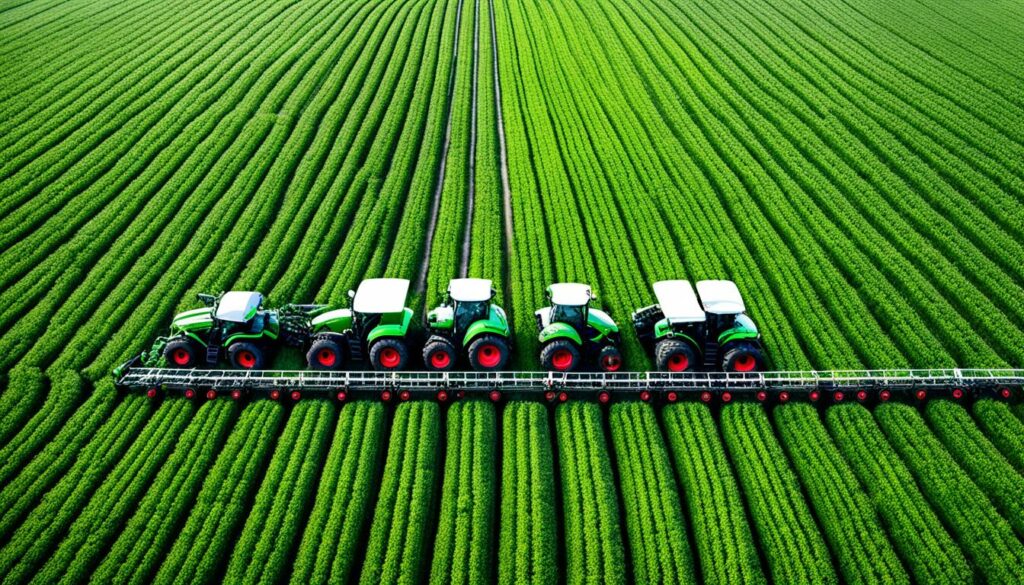
Managing farming equipment well means fixing problems early and using resources wisely. With help from GPS devices, farmers can know when machines need care. This means less time when equipment is out of order and machines last longer. It also helps save resources and make sure they are used well. New tech that lets farmers check on things from far away helps save water and use precision to water plants.
| Key Metrics | Benefits |
|---|---|
| Equipment Usage | Identifies optimal usage and prevents overuse |
| Engine Speed | Monitors performance to ensure efficiency |
| Fuel Consumption | Optimises fuel use, reducing costs and emissions |
| Maintenance Scheduling | Prevents unexpected breakdowns, ensuring consistent productivity |
Using advanced telemetry systems and GPS in farming improves how we use resources. It also makes farming more sustainable. This helps the environment and makes farming more efficient.
Through our journey, we’ve seen how crucial it is to use new tech and methods to cut down on farming’s carbon footprint. Studies, such as those by Yu et al. (2022) and Xue et al. (2014), show that using tailored strategies for managing land, water, and carbon is key. This varies in different areas.
Global data from the FAO in 2021 clearly shows the need for sustainable farming practices. Pan et al. (2022) point out how tech can help reduce carbon emissions, showing us a way forward. The work of Mosier et al. (2005) and Hu et al. (2023) tells us we can cut down on global warming by improving our farming methods.
Research on peanut and wine production, done by Pang et al. (2021) and da Silva and Esteves da Silva (2022), highlight how crop management plays a big role in reducing our carbon footprint. Ali et al. (2018) in Italy shows us that focusing on energy efficiency is crucial.
Looking forward, integrating eco-friendly tools, from precision farming to IoT sensors, is vital. These tools not just make farming better; they also help us create a farm future that’s good for the planet. This way, sustainable agriculture will ensure we have enough food while protecting our environment.
Eco-friendly farming tools are designed to be good for the earth. They use materials that won’t harm it. They save energy and rely on sources like the sun for power. By using these tools, we cut down on the gases that cause climate change. This helps make farming kinder to the planet.
Sustainable farming is key to looking after our world. It aims to keep natural resources safe. It lessens the bad effects farming can have on the environment. By doing this type of farming, we help make sure we can always grow enough food.
Traditional farming has done harm to the environment. It led to cutting down forests and ruining the soil. It also made plants and animals disappear. All this makes the earth’s air too dirty and harms our planet.
Biodegradable materials can break down over time. This helps keep our surroundings clean. It means farming tools won’t stay as waste. Instead, they can turn into things that help the environment.
Some examples of these tools are plant pots and seed trays. They’re made of bioplastics from things like corn and sugarcane. Once they’re not needed, they break down harmlessly. This is great for farming in a way that doesn’t hurt the earth.
Using recycled steel is good in many ways. It helps save energy and keeps the air cleaner. It makes farming machines strong and lasts longer. It’s a step towards making farming more about caring for our planet.
Yes, there are stories that show how using old steel in farming works well. They prove that used materials can still be good. This is a way to farm that’s kinder to nature.
Machines that use less fuel are good for farms. They cost less to run and don’t make the air dirty. These machines are also friends to the earth. They use smart ways to do the farm work that don’t waste money or harm the planet.
Tools powered by the sun are changing how farms use energy. They don’t need oil or gas, which is better for the air. Using these tools means farming can be done without making the greenhouse gas problem worse.
GPS helps farms use their land and water better. It knows exactly where we need more or less of something. This makes sure we only use what we must. It’s about growing food smartly without waste.
Smart systems know exactly what crops need to grow. They don’t use more water or plant food than they have to. This saves water and makes sure do crops grow well. Using smart systems is a step towards farming that’s good for the earth and efficient.
We use flying drones and eyes in the sky to watch how crops are doing. They tell us if pests are eating the plants. We also put out smart traps that catch the pests before they do too much harm. This means we don’t always have to use chemicals to protect our crops.
Growing food up instead of out saves space and water. It doesn’t need many chemicals that can harm the earth. Doing farming this way is a big step forward. It’s a way to grow a lot of food without spoiling our planet.
Tractors and tools that run on electricity are good for the air. They stop harmful gasses from machines from floating up. Big brands are making more of these kinds of machines. They offer hope for farming that’s both efficient and planet-friendly.
Organic farming keeps the ground, water and air clean. It doesn’t use chemicals that can hurt the earth. This way of farming helps make sure the soil stays alive. It’s about growing food in a way that doesn’t spoil nature.
Farming with the help of science can make things better and cleaner. It means using less water and food while still growing a lot. But, we need to make sure these new ways are good for the planet too.
These tools are meant to help farming not make the earth too hot. They work in ways that don’t add to the air’s dirty problems. They use new ideas to help farming be part of the solution, not the problem.
Digital systems with smart sensors tell farmers what their crops need as they grow. This makes farming more clever and careful. Instead of using too much, we can use just what’s needed. It’s about farming in a way that’s sharp and kind to our planet.
GPS and smart systems help farmers use water and food better. They know what plants need, where and when. This means no waste and everything is used just right. It’s about farming without throwing anything away or using too much.